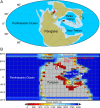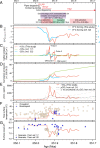Massive and rapid predominantly volcanic CO2 emission during the end-Permian mass extinction
- PMID: 34493684
- PMCID: PMC8449420
- DOI: 10.1073/pnas.2014701118
Massive and rapid predominantly volcanic CO2 emission during the end-Permian mass extinction
Abstract
The end-Permian mass extinction event (∼252 Mya) is associated with one of the largest global carbon cycle perturbations in the Phanerozoic and is thought to be triggered by the Siberian Traps volcanism. Sizable carbon isotope excursions (CIEs) have been found at numerous sites around the world, suggesting massive quantities of 13C-depleted CO2 input into the ocean and atmosphere system. The exact magnitude and cause of the CIEs, the pace of CO2 emission, and the total quantity of CO2, however, remain poorly known. Here, we quantify the CO2 emission in an Earth system model based on new compound-specific carbon isotope records from the Finnmark Platform and an astronomically tuned age model. By quantitatively comparing the modeled surface ocean pH and boron isotope pH proxy, a massive (∼36,000 Gt C) and rapid emission (∼5 Gt C yr-1) of largely volcanic CO2 source (∼-15%) is necessary to drive the observed pattern of CIE, the abrupt decline in surface ocean pH, and the extreme global temperature increase. This suggests that the massive amount of greenhouse gases may have pushed the Earth system toward a critical tipping point, beyond which extreme changes in ocean pH and temperature led to irreversible mass extinction. The comparatively amplified CIE observed in higher plant leaf waxes suggests that the surface waters of the Finnmark Platform were likely out of equilibrium with the initial massive centennial-scale release of carbon from the massive Siberian Traps volcanism, supporting the rapidity of carbon injection. Our modeling work reveals that carbon emission pulses are accompanied by organic carbon burial, facilitated by widespread ocean anoxia.
Keywords: CO2; Earth system model; compound specific carbon isotopes; end-Permian mass extinction.
Copyright © 2021 the Author(s). Published by PNAS.
Conflict of interest statement
The authors declare no competing interest.
Figures





Similar articles
-
Earth system instability amplified biogeochemical oscillations following the end-Permian mass extinction.Nat Commun. 2025 Apr 18;16(1):3703. doi: 10.1038/s41467-025-59038-0. Nat Commun. 2025. PMID: 40251165 Free PMC article.
-
Six-fold increase of atmospheric pCO2 during the Permian-Triassic mass extinction.Nat Commun. 2021 Apr 9;12(1):2137. doi: 10.1038/s41467-021-22298-7. Nat Commun. 2021. PMID: 33837195 Free PMC article.
-
Ocean acidification and the Permo-Triassic mass extinction.Science. 2015 Apr 10;348(6231):229-32. doi: 10.1126/science.aaa0193. Science. 2015. PMID: 25859043
-
The carbon isotope composition of ancient CO2 based on higher-plant organic matter.Philos Trans A Math Phys Eng Sci. 2002 Apr 15;360(1793):633-58. doi: 10.1098/rsta.2001.0965. Philos Trans A Math Phys Eng Sci. 2002. PMID: 12804297 Review.
-
Multiple factors in the origin of the Cretaceous/Tertiary boundary: the role of environmental stress and Deccan Trap volcanism.Geol Rundsch. 1996 Jun;85(2):191-210. doi: 10.1007/BF02422228. Geol Rundsch. 1996. PMID: 11543126 Review.
Cited by
-
Marine siliceous ecosystem decline led to sustained anomalous Early Triassic warmth.Nat Commun. 2022 Jun 18;13(1):3509. doi: 10.1038/s41467-022-31128-3. Nat Commun. 2022. PMID: 35717338 Free PMC article.
-
The great catastrophe: causes of the Permo-Triassic marine mass extinction.Natl Sci Rev. 2023 Oct 25;11(1):nwad273. doi: 10.1093/nsr/nwad273. eCollection 2024 Jan. Natl Sci Rev. 2023. PMID: 38156041 Free PMC article. Review.
-
Volcanic CO2 degassing postdates thermogenic carbon emission during the end-Permian mass extinction.Sci Adv. 2023 Feb 15;9(7):eabq4082. doi: 10.1126/sciadv.abq4082. Epub 2023 Feb 15. Sci Adv. 2023. PMID: 36791190 Free PMC article.
-
Global cooling drove diversification and warming caused extinction among Carboniferous-Permian fusuline foraminifera.Sci Adv. 2025 Jun 20;11(25):eadv2549. doi: 10.1126/sciadv.adv2549. Epub 2025 Jun 20. Sci Adv. 2025. PMID: 40540564 Free PMC article.
-
Tracing energy inputs into the seafloor using carbonate sediments.Proc Natl Acad Sci U S A. 2023 Feb 28;120(9):e2215833120. doi: 10.1073/pnas.2215833120. Epub 2023 Feb 21. Proc Natl Acad Sci U S A. 2023. PMID: 36802429 Free PMC article.
References
-
- Shen S. Z., et al. ., Calibrating the end-Permian mass extinction. Science 334, 1367–1372 (2011). - PubMed
-
- Davydov V., Tunguska coals, Siberian sills and the Permian-Triassic extinction. Earth Sci. Rev. 212, 103438 (2021).
Publication types
LinkOut - more resources
Full Text Sources
Miscellaneous

